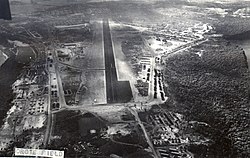Orote Field | |
 Orote Field in 1945 | |
| Location | Orote Peninsula, Naval Base Guam |
|---|---|
| Nearest city | Santa Rita, Guam |
| Coordinates | 13°26′13″N144°38′30″E / 13.43694°N 144.64167°E |
| Built | 1943 |
| NRHP reference No. | 75002149 [1] |
| Added to NRHP | June 18, 1975 |
Orote Field is a former air base in the United States territory of Guam built by the Empire of Japan with Chamorro forced labor during the Japanese occupation of Guam (1941-1944). It is separate from the Marine Corps amphibious airplane base at located at Sumay village that was operational from 1921 to 1931. Following the liberation of Guam in 1944, the U.S. military repaired the field for further use in the Pacific War.
Contents
Located on Naval Base Guam, Orote Field was largely abandoned after World War II except for occasional training exercises. One major event in 1975 was Operation New Life, when a tent city for tens of thousands of South Vietnamese refugees was erected at the field. The field was listed on the National Register of Historic Places in 1975.

